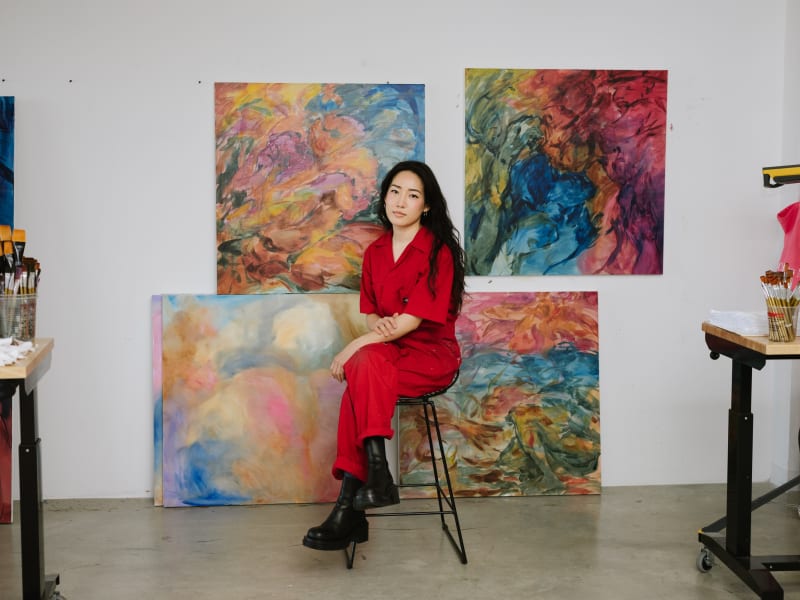Around 20 seconds is said to be the average time spent looking at a work of art today. But the paintings of emerging artist Julia Jo beckon the viewer to linger longer. The Brooklyn-based talent's delirious abstractions overflow with figurative promises. Between dense layers of fiery reds, nocturnal blues, and glowing turquoises are dramatic universes that brim with fleeting instances-a hand raises a glass or two lips coquettishly lock. Look again, and those scenes may have already evanesced. "I want my paintings to have lives on their own and not be limited to who I am," Jo says. "Beyond my mark making, they should freely answer any question the viewer has."
Jo's first solo New York exhibition, "Riptide," at Charles Moffett in January, caught the attention of collectors. She makes her West Coast debut this summer, at James Fuentes's Melrose Avenue space in L.A., and a second solo show, in September at San Francisco's Jessica Silverman gallery, will continue her bicoastal success.
The fascination around the artist's technique partially lies in pulling cues from common complexities of everyday interactions. "I am always thinking about social relationships and the difficulty of putting certain emotions into words," Jo says from her studio. "How do you, for example, paint feeling inadequate or jealous?"
Born in South Korea and educated at different boarding schools across the U.S., she has experienced both the challenges and advantages of growing up in a multitude of environments. The biggest reward has doubtlessly been crafting her unique painterly language through observations of a life in drift. Behind the erratic washes of color, Jo's paintings capture the relatable struggles of fitting in and being understood.
Deeply inspired by art history, Jo looks to Hieronymus Bosch's grotesque detailing of biblical myth and the bucolic depictions of societal rituals in the Baroque as well as Cecily Brown's kaleidoscopic marrying of color and form. "I want to create what only a painting can do," she says. "I want the work to fool the viewer because that push and pull makes seeing a painting feel satisfying."
Jo's first solo New York exhibition, "Riptide," at Charles Moffett in January, caught the attention of collectors. She makes her West Coast debut this summer, at James Fuentes's Melrose Avenue space in L.A., and a second solo show, in September at San Francisco's Jessica Silverman gallery, will continue her bicoastal success.
The fascination around the artist's technique partially lies in pulling cues from common complexities of everyday interactions. "I am always thinking about social relationships and the difficulty of putting certain emotions into words," Jo says from her studio. "How do you, for example, paint feeling inadequate or jealous?"
Born in South Korea and educated at different boarding schools across the U.S., she has experienced both the challenges and advantages of growing up in a multitude of environments. The biggest reward has doubtlessly been crafting her unique painterly language through observations of a life in drift. Behind the erratic washes of color, Jo's paintings capture the relatable struggles of fitting in and being understood.
Deeply inspired by art history, Jo looks to Hieronymus Bosch's grotesque detailing of biblical myth and the bucolic depictions of societal rituals in the Baroque as well as Cecily Brown's kaleidoscopic marrying of color and form. "I want to create what only a painting can do," she says. "I want the work to fool the viewer because that push and pull makes seeing a painting feel satisfying."


